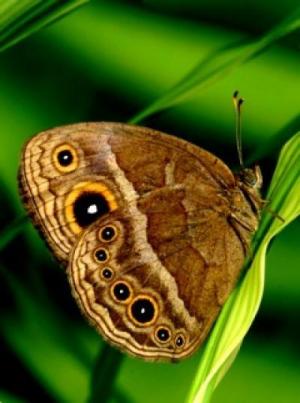We're open daily! View holiday hours
Science News
Cool Temps Mean Choosier Males
January 18, 2011

By Anne Holden
In the animal kingdom, females have very high expectations. Across thousands of species, they choose their mates based on the brightness of plumes or the boldness of facial markings. By contrast, males pull out all the stops as suitors in the hope that the female will like what she sees. But new research into the sexual behavioral patterns of butterflies has shown that, given the right environment, males can be just as choosy.
The process by which males evolve beautiful (and often impractical) attributes to impress the ladies is called sexual selection. The term, coined by Charles Darwin, describes the struggle between males for the attention of a female. Males evolve ever bigger and more elaborate ornaments over many generations, competing against other males for the attention of a female.
But one member of the animal kingdom does things a bit differently. Yale University scientists, led by Kathleen Prudic, were intrigued by the squinting bush brown butterflies (Bicyclys anynana) because courtship behavior seemed to be reversed.
The majority of the time, the butterflies’ behavior wasn’t that unusual. Males had black eye-shaped wing spots and displayed them to a female who chose her favorite. But sometimes, the roles are reversed. In these cases, it’s the females who develop the wing spots and display them for the males. The males then choose their favorite female. Prudic and her team set out to find the answers behind this puzzling behavior. Their results are described in the January 7th issue of Science.
They thought this role reversal could be linked to changes in weather, so they raised two groups of butterfly larvae in two very different temperatures: one group was raised in warm and moist conditions, the other in a cool and dry place.
When the butterflies emerged from their cocoons, Prudic and her team noticed the differences immediately. The female butterflies that were raised in the warm environment didn’t develop the black wing spots. Moreover, they were quite choosy and more likely to mate with males who had the biggest wing spots. Females raised in the cool and dry environment were very different. They developed their own comparable black wing spots and played the role of suitors, trying to impress their male counterparts.
Prudic believes this role reversal may have something to do with food. When males mate with females, they not only deliver sperm, but much needed nutrients as well. In cooler, dryer climates, food is harder to find. Females must think outside the box to survive. In the case of the squinting bush brown butterflies, this means displaying to and mating with as many males as possible. Males, on the other hand, need to conserve their resources, and tend to be choosier.
Prudic and her team are excited what this research could mean about the developmental and evolutionary mechanisms behind all that sexual selection has produced—plumes, feathers, and all.
Anne Holden, a docent at the California Academy of Sciences, is a PhD trained genetic anthropologist and science writer living in San Francisco.
Image credit: William H. Piel and Antonia Monteiro/Courtesy of Yale University